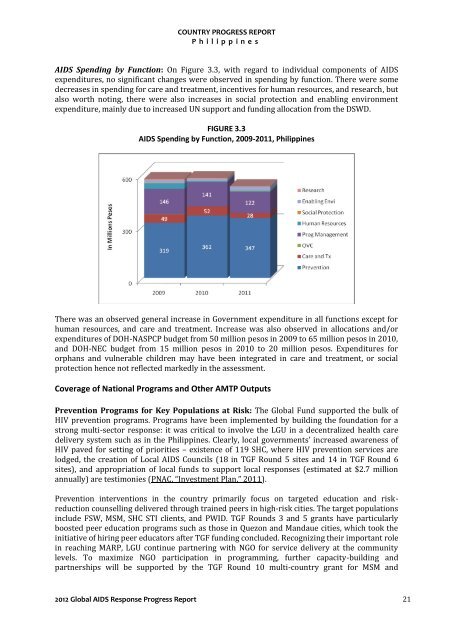Download this publication - HIV/AIDS Data Hub
Download this publication - HIV/AIDS Data Hub
Download this publication - HIV/AIDS Data Hub
Create successful ePaper yourself
Turn your PDF publications into a flip-book with our unique Google optimized e-Paper software.
COUNTRY PROGRESS REPORTP h i l i p p i n e s<strong>AIDS</strong> Spending by Function: On Figure 3.3, with regard to individual components of <strong>AIDS</strong>expenditures, no significant changes were observed in spending by function. There were somedecreases in spending for care and treatment, incentives for human resources, and research, butalso worth noting, there were also increases in social protection and enabling environmentexpenditure, mainly due to increased UN support and funding allocation from the DSWD.FIGURE 3.3<strong>AIDS</strong> Spending by Function, 2009-2011, PhilippinesThere was an observed general increase in Government expenditure in all functions except forhuman resources, and care and treatment. Increase was also observed in allocations and/orexpenditures of DOH-NASPCP budget from 50 million pesos in 2009 to 65 million pesos in 2010,and DOH-NEC budget from 15 million pesos in 2010 to 20 million pesos. Expenditures fororphans and vulnerable children may have been integrated in care and treatment, or socialprotection hence not reflected markedly in the assessment.Coverage of National Programs and Other AMTP OutputsPrevention Programs for Key Populations at Risk: The Global Fund supported the bulk of<strong>HIV</strong> prevention programs. Programs have been implemented by building the foundation for astrong multi-sector response: it was critical to involve the LGU in a decentralized health caredelivery system such as in the Philippines. Clearly, local governments’ increased awareness of<strong>HIV</strong> paved for setting of priorities – existence of 119 SHC, where <strong>HIV</strong> prevention services arelodged, the creation of Local <strong>AIDS</strong> Councils (18 in TGF Round 5 sites and 14 in TGF Round 6sites), and appropriation of local funds to support local responses (estimated at $2.7 millionannually) are testimonies (PNAC, “Investment Plan,” 2011).Prevention interventions in the country primarily focus on targeted education and riskreductioncounselling delivered through trained peers in high-risk cities. The target populationsinclude FSW, MSM, SHC STI clients, and PWID. TGF Rounds 3 and 5 grants have particularlyboosted peer education programs such as those in Quezon and Mandaue cities, which took theinitiative of hiring peer educators after TGF funding concluded. Recognizing their important rolein reaching MARP, LGU continue partnering with NGO for service delivery at the communitylevels. To maximize NGO participation in programming, further capacity-building andpartnerships will be supported by the TGF Round 10 multi-country grant for MSM and2012 Global <strong>AIDS</strong> Response Progress Report 21















